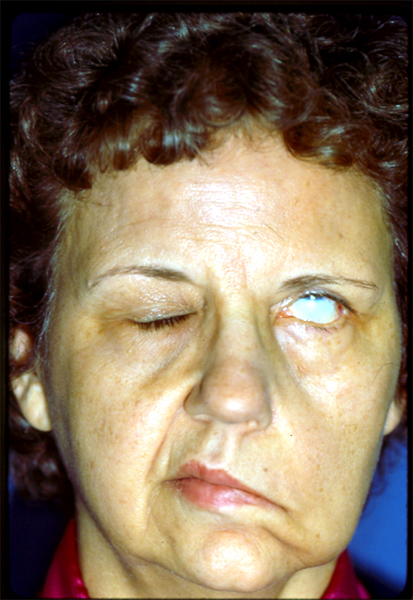Chapter 15 – Neurological system assessment
CN VII – Facial Nerves
- Motor function testing – facial asymmetry: Observe for facial asymmetry such as flattening of nasolabial fold, lack of wrinkles on forehead, drooping of the eyebrow, or decreased or absent blinking.
- Normally, there is no asymmetry and the client is able to blink.
- Abnormal findings include decreased blinking and flattening of nasolabial fold, asymmetry of eyebrows with one drooping (see Figure 15).
- Motor function testing – facial muscle movement: Explain to the client that you will ask them to move their facial muscles in different positions. It is simplest if you demonstrate the movement and ask them to mimic it. Observe the client for movement and symmetry of movement (see Video 10).
-
- Move eyebrows upwards and crease the forehead.
- Smile while showing teeth.
- Puff out cheeks with air and hold, while you press gently on the cheeks in and out 2 to 3 times.
- Close eyes and keep them closed, while you try to spread them open with your index fingers on the upper orbital bones and thumbs on the lower orbital bones.
- Normally, the client should be able to perform all movements symmetrically, should be able to keep cheeks puffed out when you press on them, and should be able to keep their eyes closed while you try to open them.
- Abnormal findings include lack of movement, asymmetrical movement, inability to keep cheeks puffed out, and inability to keep eyes closed.
Video 10: Facial movements.
- Sensory Sensation: To test taste related to CN VII, use a familiar substance such as sugar or salt, but do not tell the client what the substance is. Place the substance in a small amount of water and stir it with a cotton swab until it dissolves. Ask the client to open their mouth and you place the swab on the dorsal anterior third of the tongue (not on the tip of the tongue). Ask the client to identify the taste.
- Normally, the client should be able to identify the taste or substance.
- Abnormal findings include inability or reduced ability to identify the taste or substance or decreased taste.
- Note the findings:
- Normal findings might be documented as: “Facial nerves testing: No asymmetry of eyebrows, blinking automatically, symmetrical movement of face. Client able to identify taste with cotton-tipped applicator soaked in sugar.”
- Abnormal findings might be documented as: “Facial nerves testing: Right eyebrow droops, client unable to wrinkle forehead or raise right eyebrow. Client unable to identify sweet taste of cotton-tipped applicator soaked in sugar.”

Figure 15: Facial asymmetry.
(By Student30 – This file is licensed under the Creative Commons Attribution-Share Alike 4.0 International license.
https://commons.wikimedia.org/w/index.php?curid=61665721)

